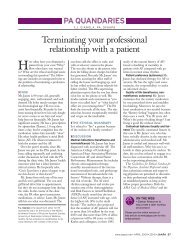Essential Guide to E-mail Marketing - Haymarket
Essential Guide to E-mail Marketing - Haymarket
Essential Guide to E-mail Marketing - Haymarket
Create successful ePaper yourself
Turn your PDF publications into a flip-book with our unique Google optimized e-Paper software.
04 FEATURE DM News • E-Mail <strong>Marketing</strong> <strong>Guide</strong> 2007<br />
Q&A<br />
A conversation with AOL’s Charles Stiles<br />
BY DIANNA DILWORTH<br />
Spam is a never-ending problem. Overall spam levels in<br />
August 2007 increased <strong>to</strong> an average of 69% of <strong>to</strong>tal e<strong>mail</strong>,<br />
according <strong>to</strong> the September issue of Symantec’s<br />
monthly spam report. It seems that no sooner does a<br />
spam-blocking firm or ISP identify and s<strong>to</strong>p a spam phenomenon<br />
than a new one pops up. DM News spoke with AOL postmaster<br />
Charles Stiles about the state of spam <strong>to</strong>day, the lingering<br />
challenges and what this means <strong>to</strong> legitimate e-<strong>mail</strong> marketers.<br />
DM News: What are the biggest spam problems you’ve seen in<br />
recent months and what are you doing <strong>to</strong> track them?<br />
Charles Stiles: As of late, we are seeing a lot more criminal-type<br />
behavior. The flavor of the day right now is people taking advantage<br />
of individuals’ home computers. They are using botnets, which take<br />
over home computers <strong>to</strong> send out spam. There is that type of activity,<br />
and then there is registering fraudulent accounts, and that’s really<br />
what it comes down <strong>to</strong>. It’s no longer legitimate marketers using bad<br />
practices. It’s really about criminal activity now.<br />
DM News: How do you deal with this huge problem of botnets,<br />
especially when sometimes one can fall on<strong>to</strong> a computer and only<br />
be active for an hour before erasing itself?<br />
CS: One of the things that we do is we try and figure out how<br />
these machines are connecting <strong>to</strong> us. Typically they are coming<br />
through and sending stuff out on Port 25, that’s the standard <strong>mail</strong><br />
port. So AOL doesn’t use the same standard <strong>mail</strong> port. Instead we<br />
require people <strong>to</strong> authenticate. You can’t just send e-<strong>mail</strong> off of our<br />
<strong>mail</strong> servers when you are connected. You have <strong>to</strong> actually provide<br />
a user name and password. Now with our clients, it’s done in the<br />
background, you don’t see it, and with Outlook or other thirdparty<br />
clients, you can configure it. But we do require user name<br />
“<br />
Charles Stiles, Postmaster, AOL<br />
ESSENTIAL GUIDE<br />
and password so that not just anybody can connect.<br />
We also track how much <strong>mail</strong> each account is sending, whether<br />
you are using our client or whether you are using a third-party<br />
<strong>mail</strong> client. This is not so much <strong>to</strong> make sure that you don’t send<br />
<strong>to</strong>o much <strong>mail</strong>, but we look at your pattern of sending. If you<br />
only sent five or 10 messages a day on average and suddenly you<br />
just sent out 500, that’s certainly outside of your normal pattern —<br />
very similar <strong>to</strong> what a credit card issuer might do — in which<br />
case we would challenge you. And we wouldn’t necessarily just<br />
block you, but we would offer you a challenge <strong>to</strong> say, “Is this a<br />
real human behind this? Is she sending us a message and this is<br />
just outside of her norm?”<br />
We would also use what you call a capture test or the image challenge<br />
test. So long as you passed it, you are fine <strong>to</strong> go ahead and<br />
continue sending. If you don’t, then we will probably scramble your<br />
password and say OK, we’re just not going <strong>to</strong> allow you <strong>to</strong> connect<br />
<strong>to</strong> the servers anymore. Then there’s an online process whereby you<br />
can get it unscrambled, but you again have <strong>to</strong> pass that capture test,<br />
just <strong>to</strong> make sure that it is a human that is behind the keyboard.<br />
DM News: So how are spammers getting more sophisticated, and<br />
what is going on with image spam?<br />
CS: Spammers have started using images as opposed <strong>to</strong> just text on<br />
a lot of these messages, because they have found that the text is easily<br />
deciphered by most of our filters and engines. So instead they’ll<br />
put <strong>to</strong>gether a picture that contains all the text that they would<br />
need for their spam message. But because sending the same picture<br />
over and over would be easily detected, they change it and put<br />
static in it or additional elements so that it is very difficult <strong>to</strong> track.<br />
DM News: And what are some of the things that you are doing <strong>to</strong><br />
track image spam? Is it also part of the authentication and login<br />
process?<br />
Even if a marketer did have express written consent from the consumer, if they<br />
had copies of his driver’s license, knew his address, his telephone number,<br />
blood type, if at the end of the day, the consumer says,‘I don’t want it,’ then we<br />
want the <strong>mail</strong>er <strong>to</strong> s<strong>to</strong>p <strong>mail</strong>ing it <strong>to</strong> them.”
















